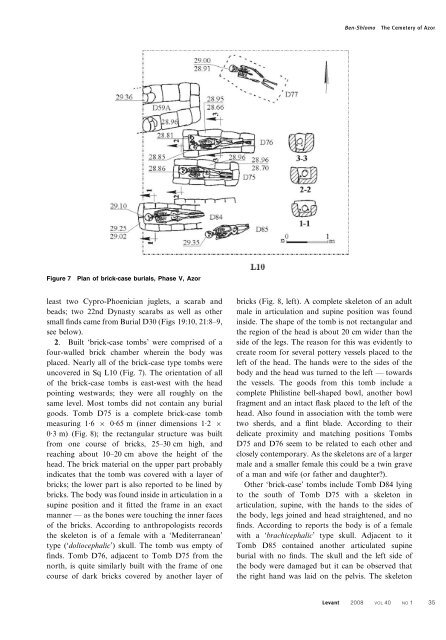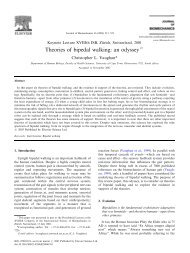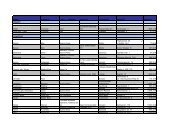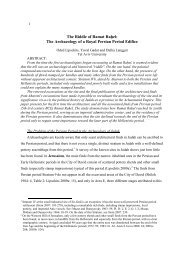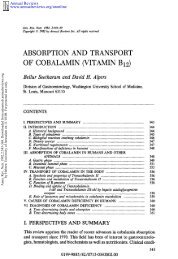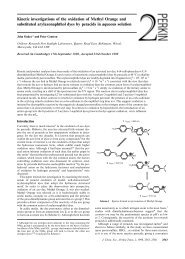The Cemetery of Azor and Early Iron Age Burial Practices
The Cemetery of Azor and Early Iron Age Burial Practices
The Cemetery of Azor and Early Iron Age Burial Practices
You also want an ePaper? Increase the reach of your titles
YUMPU automatically turns print PDFs into web optimized ePapers that Google loves.
Ben-Shlomo<strong>The</strong> <strong>Cemetery</strong> <strong>of</strong> <strong>Azor</strong>Figure 7Plan <strong>of</strong> brick-case burials, Phase V, <strong>Azor</strong>least two Cypro-Phoenician juglets, a scarab <strong>and</strong>beads; two 22nd Dynasty scarabs as well as othersmall finds came from <strong>Burial</strong> D30 (Figs 19:10, 21:8–9,see below).2. Built ‘brick-case tombs’ were comprised <strong>of</strong> afour-walled brick chamber wherein the body wasplaced. Nearly all <strong>of</strong> the brick-case type tombs wereuncovered in Sq L10 (Fig. 7). <strong>The</strong> orientation <strong>of</strong> all<strong>of</strong> the brick-case tombs is east-west with the headpointing westwards; they were all roughly on thesame level. Most tombs did not contain any burialgoods. Tomb D75 is a complete brick-case tombmeasuring 1 . 6 6 0 . 65 m (inner dimensions 1 . 2 60 . 3 m) (Fig. 8); the rectangular structure was builtfrom one course <strong>of</strong> bricks, 25–30 cm high, <strong>and</strong>reaching about 10–20 cm above the height <strong>of</strong> thehead. <strong>The</strong> brick material on the upper part probablyindicates that the tomb was covered with a layer <strong>of</strong>bricks; the lower part is also reported to be lined bybricks. <strong>The</strong> body was found inside in articulation in asupine position <strong>and</strong> it fitted the frame in an exactmanner — as the bones were touching the inner faces<strong>of</strong> the bricks. According to anthropologists recordsthe skeleton is <strong>of</strong> a female with a ‘Mediterranean’type (‘doliocephalic’) skull. <strong>The</strong> tomb was empty <strong>of</strong>finds. Tomb D76, adjacent to Tomb D75 from thenorth, is quite similarly built with the frame <strong>of</strong> onecourse <strong>of</strong> dark bricks covered by another layer <strong>of</strong>bricks (Fig. 8, left). A complete skeleton <strong>of</strong> an adultmale in articulation <strong>and</strong> supine position was foundinside. <strong>The</strong> shape <strong>of</strong> the tomb is not rectangular <strong>and</strong>the region <strong>of</strong> the head is about 20 cm wider than theside <strong>of</strong> the legs. <strong>The</strong> reason for this was evidently tocreate room for several pottery vessels placed to theleft <strong>of</strong> the head. <strong>The</strong> h<strong>and</strong>s were to the sides <strong>of</strong> thebody <strong>and</strong> the head was turned to the left — towardsthe vessels. <strong>The</strong> goods from this tomb include acomplete Philistine bell-shaped bowl, another bowlfragment <strong>and</strong> an intact flask placed to the left <strong>of</strong> thehead. Also found in association with the tomb weretwo sherds, <strong>and</strong> a flint blade. According to theirdelicate proximity <strong>and</strong> matching positions TombsD75 <strong>and</strong> D76 seem to be related to each other <strong>and</strong>closely contemporary. As the skeletons are <strong>of</strong> a largermale <strong>and</strong> a smaller female this could be a twin grave<strong>of</strong> a man <strong>and</strong> wife (or father <strong>and</strong> daughter?).Other ‘brick-case’ tombs include Tomb D84 lyingto the south <strong>of</strong> Tomb D75 with a skeleton inarticulation, supine, with the h<strong>and</strong>s to the sides <strong>of</strong>the body, legs joined <strong>and</strong> head straightened, <strong>and</strong> n<strong>of</strong>inds. According to reports the body is <strong>of</strong> a femalewith a ‘brachicephalic’ type skull. Adjacent to itTomb D85 contained another articulated supineburial with no finds. <strong>The</strong> skull <strong>and</strong> the left side <strong>of</strong>the body were damaged but it can be observed thatthe right h<strong>and</strong> was laid on the pelvis. <strong>The</strong> skeletonLevant 2008 VOL 40 NO 1 35


